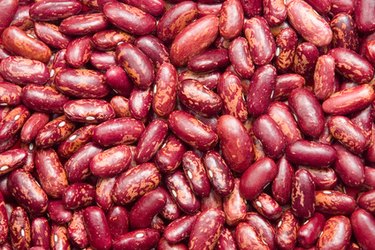
While many foods are perfectly fine to eat right off the vine or out of the ground, red kidney beans are not one of them. Though many raw beans contain the toxin Phytohaemagglutinin, also called kidney bean lectin, kidney beans contain the highest toxin levels. Cooked beans also contain the toxin, but in much lower and harmless levels. Soaking and cooking the beans destroys enough of the toxin so that symptoms do not occur.
Cause
Video of the Day
The toxin in red kidney beans, called Phytohaemagglutinin, or kidney bean lectin, is a naturally occurring protein that may protect the plant from harm. Kidney bean lectin is measured in toxin units called hemagglutinating units, or hau for short. Uncooked kidney beans contain 20,000 to 70,000 hau; cooking the beans reduces the toxin level to 200 to 400 hau. White kidney beans contain only around one-third the toxin level of red kidney beans, according to the Food and Drug Administration. Eating as few as four or five raw red kidney beans is enough to cause symptoms.
Video of the Day
Effects
Symptoms of kidney bean lectin poisoning start one to three hours after eating the beans and include severe gastrointestinal symptoms, including severe nausea and vomiting. Diarrhea follows within a few hours; some people also develop abdominal pain. Most people recover rapidly, although some require hospitalization and intravenous fluids. Outbreaks are reported more frequently in the United Kingdom than in the United States, which may be related to better recognition and diagnosis of symptoms in the U.K. or more frequent consumption of dried beans. Lectin causes gastrointestinal symptoms by interfering with the mucosal layer of the intestine, possibly binding to the intestinal cell walls.
Prevention
Soaking red kidney beans for at least five hours and then cooking them in boiling water for at least 10 minutes is enough to lower the toxin content, according to the FDA. Use fresh water for boiling; do not use the water used to soak the beans, which leach out the toxin.
Considerations
Cooking red kidney beans in crock pots or slow cookers may not heat them enough to destroy the toxin and may actually potentiate it. Heating to a temperature of 176 degrees Fahrenheit may increase the toxin levels by as much as five times, FoodReference.com reports. Crock pots often don't reach temperatures greater than 167. Using dry heat to cook the beans does not appear to inactivate the toxin, Cornell University Department of Animal Science warns. In reported cases, 100 percent of people who ate the beans developed symptoms; age and sex don't appear to affect the symptoms, which vary in intensity according to how many beans were ingested, according to the FDA.